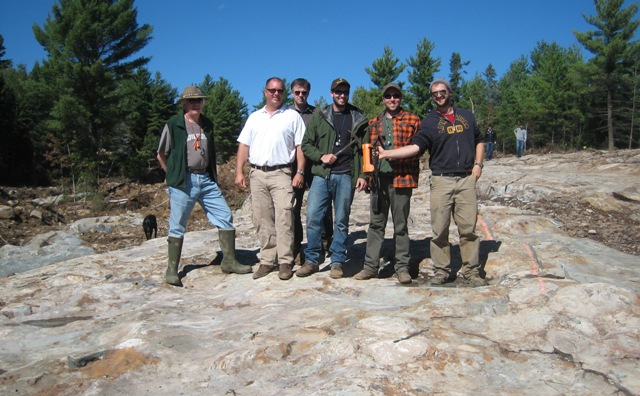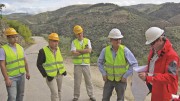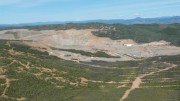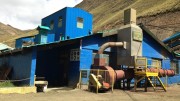SUDBURY, ONTARIO — The Sudbury region has served up more than its fair share of intriguing economic geology over the years, and now Sudbury-based junior Ginguro Exploration (TSXV: GEG) is adding another geological puzzle to the mix in the form of its Pardo paleo-placer gold deposit.
Situated an easy drive 65 km northeast of Sudbury in Pardo Towship, the 113 sq. km Pardo property has Ginguro holding 100% ownership in a 80 sq. km doughnut around the property, while the 33 sq. km heart of the project is held in a joint venture with Vancouver-based Endurance Gold (TSXV: EDG; US-OTC: ENDGF), with Ginguro as majority owner and operator.
Ginguro (the G’s are pronounced as in “gin” and “guru”) bills its flagship Pardo project as the “first large-scale paleo-placer gold deposit in North America” with a geological signature reminiscent of the famed Witwatersrand paleo-placer mega-deposit, which has supplied more gold to the world than any other source — maybe half of all gold ever mined.
Over the last five years at Pardo, Ginguro has identified and better delineated a flat-lying, gold-bearing channelized conglomerate reef system that extends 11 km north–south and 4 km east–west. The system represents a braided river-delta environment, with the ancient river having flowed in what would today be a north-to-south direction, so that the grain sizes get smaller towards the south.
The reef system lies in relatively undisturbed horizontal beds, with much of it right at surface or beneath a metre or two of overburden.
Ginguro has so far focused on three areas in the north-central part of the paleo-delta characterized by finer-grained material, including gold mixed in with coarser pebbles, cobbles and gravels: Trench 2 (stripped in 2007 by a previous operator), and two zones only discovered and stripped in the third quarter of 2013, named the “007 Zone” (yes, after James Bond) and Eastern Reef. The 200-metre long Eastern Reef is 60 metres east of Trench 2, and 600 metres northeast of the smaller 007 Zone.
Stratigraphically, the conglomerates in all three areas are part of the Mississagi Formation of the Hough Lake Group, which forms part of the ancient Huronian Supergroup. These rocks are incredibly old — at least 2.3 billion years — and the Proterozoic-age paleo-depositional environment suggest a reducing atmosphere, as inferred by grey-hued sandstones.
Yet Pardo is a youngster compared to the 3-billion-year-old Wits basin, which was created during the Archean, when there was not yet any oxygen in the atmosphere.
But as is the case in the Wits basin, much of the gold mineralization at Pardo is coincident with paleo-placer uranium mineralization in the form of uraninite, so simple hand-held radiometric surveying has proven to be an invaluable technique for finding gold in bedrock under the area’s thin but extensive overburden.
During a visit to the property by The Northern Miner in September 2013, Ginguro geologist Winston Whymark scampered across the exposed outcrop at 007 zone, showing how his portable radiometric spectrometer would scream and go off-scale whenever he approached the high-grade gold zones.
“We couldn’t have made a better investment than that spectrometer, that’s for sure,” he beamed. “The dots are here, and we’re connecting them.”
So far, Ginguro has stripped, lightly drilled and channel-sampled all three areas, with some intriguing high-grade gold values found last year right at surface.
At 007 Zone, which has an estimated true thickness of 2 metres, channel sampling along a pyritic boulder conglomerate unit delivered 40.1 grams gold per tonne over 22.5 metres, while Eastern Reef, which has a true thickness of 2 to 6 metres, has returned 4.4 grams gold over 42.5 metres in channel sampling, mostly of a boulder conglomerate. (Due to the flat-lying nature of the gold-bearing conglomerates, it’s not yet practical to take channel samples across the width of the gold-bearing strata.)
“The high-grade nature of the 007 Zone suggests that it represents one of the main gold-enriched channels of an ancient river system,” said Ginguro president and CEO Richard Murphy.
One of the trickier aspects of the Pardo project is that the gold is distributed unevenly in the conglomerate units. Ginguro describes the heavy alluvial minerals — gold, uraninite and pyrite — as having “tended to concentrate in the pressure shadows behind and below large cobbles and boulder clasts in the conglomerate. This indicates a high-energy, fast water-flow environment during gold deposition.”
But Ginguro says that “work to date suggests the area between these [three] zones is underlain by similar geology.”
“It looks promising,” Ginguro geologist Peter van Walraven affirmed during a lunch break atop the stripped Eastern Reef zone. “It looks exciting so far.”
While the management team at Ginguro are old hands in the Sudbury mining scene, this relatively new type of exploration target by North American standards — paleo-placer gold — prompted the company to seek out South African expertise at an advisory level.
Most notably, in early 2010 Ginguro brought in pre-eminent paleo-placer gold expert Lawrence Minter as a special advisor, especially in relation to designing and evaluating field programs. Minter holds a PhD in geology from the University of the Witwatersrand, and is a professor emeritus of geological sciences at the University of Cape Town.
At the end of 2012, in order to focus on Pardo, Ginguro sold its stake in the El Alto iron oxide copper–gold property northwest of Santiago, Chile, as well as its Wildgoose Lake property near Thunder Bay, Ont., pocketing a $3.3-million gain in the form of shares and warrants.
Along with a $725,000 financing at the end of 2012 and $2.3 million raised in the third quarter of 2013, these moves have allowed Ginguro to build up a treasury that stood at a healthy $2.8 million in cash on Sept. 30, 2013, with no debt.
As the company commented in its financial filings, “the company currently has sufficient cash to fund anticipated exploration expenditures and administrative expenditures through the end of 2015.”
(To give an idea of Ginguro’s burn rate, its general and administrative expenses during the first nine months of 2013 were only $455,000.)
However, business success is often followed by lawsuits, and Pardo has fallen into this trap, with the ownership percentages of the Pardo joint venture in dispute since the discoveries of 007 Zone and Eastern Reef.
For certain, Ginguro has owned at least 55% of the joint venture since March 2012, when it completed $1 million worth of exploration and made a $200,000 cash payment to Endurance, which kept a 45% participating ownership at the time.
Fast-forward to Oct. 24, 2013, and Ginguro started arbitration proceedings against Endurance to enforce its claimed 70.95% joint-venture ownership, which Ginguro says it earned by carrying out $1.1 million in exploration work that Endurance elected not to fund. That would mean Endurance’s stake had been diluted to 29.05%.
Ginguro has charged that Endurance is “trying to participate in a program retroactively when it clearly chose to not financially contribute to the program when it had the opportunity to do so.”
In December 2013, provincial arbitrator Dennis O’Connor was appointed by both parties to handle the dispute, and Endurance filed a counter claim.
Endurance says it “rejects that Endurance’s Pardo joint-venture property interest has been diluted as represented by Ginguro,” because it claims Ginguro carried out work in 2012 and 2013 without its approval or knowledge.
“It’s unfortunate, and it’s taking time,” Murphy said of the arbitration in an April interview. “I can’t give you a reliable date as to when it will be resolved, but the good news is, while we didn’
t do any work [in the last six months] in favour of trying to get the arbitration resolved, we changed the approach about three weeks ago, and decided to proceed with proposing a new, active exploration program and budget as operators of the joint venture.
“Notwithstanding that the arbitration process will go on, anyone can see it’s to the benefit of both parties to the joint venture for the project to be advanced.”
The proposed work would include finishing the channel sampling at the existing stripped-off outcrops, more shallow drilling for grain-size distribution analysis and carrying out the first-ever radon gas survey on a 3 km wide northern part of the property, as there has been such strong correlation between high-grade gold and uraninite grains.
Murphy says he’d like to combine radon work with ground-penetrating radar surveying through the overburden.
“It should tell us, number one, the overburden depth to the bedrock, obviously. But if we’re lucky: the location of the unconformity between the Huronian — the key strata that hosts the gold — and the underlying Archean basement rocks. There’d be a density contrast and a big contrast in the orientation of the rocks, as you’re going from Archean rocks which are tilted up vertically to the Huronian flat-lying on top of them.”
All of this work — particularly a study of different drilling methods — should help Ginguro get a better idea on how to go forward for testing an initial resource.
“It’s an interim step we need between prospecting discovery and doing the resource drilling,” Murphy said.
Bulk sampling on the order of thousands of tonnes may be part of a subsequent program, he added.
“To me, the biggest thing is to get the guys on the ground and deliver results again,’ Murphy said. “That’s the way we’re going to help ourselves and shareholders the most.”
Ginguro shares last traded at 16¢, with a 52-week range of 3¢ to 40¢. With 83.4 million shares outstanding, the market cap stands at $13 million. Ginguro shares had their biggest move in August and early September 2013, soaring from 3¢ to 36¢, when the high gold grades of the newly discovered 007 Zone and Eastern Reef were announced.
At last count, Ginguro chairman Wayne Whymark held 2.2 million shares; Murphy, 1.4 million; Ginguro chief financial officer Guy Mahaffy, 1.1 million; director Doug Hunter, 440,000; and directors Joe Prosperi and Elie Farah, nil.
Rob McEwen’s privately held company Evanachan Ltd. owned 18.4% of Ginguro as of March 31.






It would appear as if Mr.Whymark has taken the company in a storm. He almost immediately moved the company head quarters, changed the name to something that doesn’t seem to quite make any sense, have most employees who’s last name wasn’t Whymark quickly removed and on top of it all, driven the stock price down by 60%. It would seem that his methods do not sit well with shareholders and it is very evident now that he was a mistake. I am glad knowing that I sold out before he took over and just enjoy watching this circus show which he now calls Inventus.